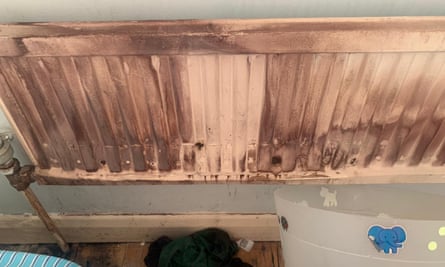It was during a night in June that two radiators exploded in Luca’s house, jetting scalding water across the bedroom of his six-year-old son and bringing down the ceilings of the ground-floor rooms. By a fluke the family was away.
“If my son had been in his bed he would have been severely burned,” says Luca. “The disaster was inevitable. In the 10 years since I bought the house, not once have the pipes and radiators been serviced, and similar things have recently happened in neighbouring properties.”
The London housing estate where Luca lives is supplied with heating and hot water by a district heating network (DHN) operated by Southwark council.
DHNs generate heating from a central source to a whole community via a network of insulated hot water pipes, eliminating the need for individual household boilers.
There are about 14,000 in the UK run by councils, housing associations and private companies, supplying nearly 500,000 homes. They’re considered to be a cheaper, greener alternative to traditional systems, and the Climate Change Committee has estimated they need to account for 18% of the UK’s energy supply if the country is to meet its 2050 net zero target.
‘If my son had been in bed he would have been severely burned. Not once have the radiators or pipes been serviced’Luca, Southwark resident
Many DHNs have successfully cut emissions and prices for households. However, those that are poorly designed and inadequately maintained have left some customers enduring freezing homes and enormous bills.
They are unable to switch supplier because they are locked into contracts of 25 years or longer, as soon as they buy a property supplied by a DHN. And they cannot get redress for poor service via the energy ombudsman because the sector is largely unregulated.
Campaigners have warned that thousands more people risk being trapped with unaccountable providers, as more networks are rolled out without statutory regulations.
Currently there are no controls on consumer tariffs and no technical standards to which new networks must adhere.
Developers who are required to install DHNs as a planning condition are free to choose the cheapest option, which may not be suiable, and some councils, which run their own networks, lack resources and expertise.
“There are good, well-run networks, but we cannot be confident this will become the norm, even when legislation is belatedly brought in to cover this growing sector,” says Ruth London of the campaign group Fuel Poverty Action.
The damage to Luca’s home was so extensive because DHNs operate at higher pressure and temperatures than ordinary systems, and already leaking pipes were overwhelmed.
Since the flood, the family has been living in temporary accommodation funded by their insurer. He says that he heard nothing from the council for the first three months, until the Observer intervened.
Southwark has now offered to replace the radiators, but until the malfunctioning network is overhauled, the family fears they could burst again.
Luca asked to be disconnected from the scheme so he could switch to a private supplier, but was told that, as a freeholder, he would have to pay a £39,500 fee. With this type of scheme, leaseholders and social housing tenants are not allowed to switch because their share of the costs would have to be passed to other residents.
Councillor Stephanie Cryan, Southwark’s cabinet member for council homes and homelessness, told the Observer: “I am very sorry this issue has taken some time to resolve for this family.
“While we identified a leak back in January, and we can replace all of the radiators, the wider issue is much more complex and, to date, we have been unable to come to a solution in terms of disconnection from the district heating system.”
Seventeen other Southwark residents who approached the Observer reported spending weeks in unheated homes during winter, and five-figure bills to maintain the system that let them down.
Giancarlo Niccoli was asked to pay £13,700 towards repairs of the network on his estate, after his one-bedroom flat was left without fully functioning heating for six months.
He was still billed the annual tariff of £1,000, plus a 10% administration charge, while paying for electric heaters to see him through the winter.
“The council sends multiple engineers to do the same job poorly, and then it needs repair again, at our expense, months later,” he says.
“I once had to move out while my flooring was pulled up because a botched repair caused leaks.”
Southwark insists the costs are allowable within the terms of his lease, irrespective of service standards, a fact supported by a tribunal to which Niccoli took his complaint.
In April, the council launched a compensation scheme which awards residents £3 for each day the system isn’t working, a sum residents claim is inadequate to cover electric heaters.
Jack Lewis, from the Southwark Group of Tenants Organisation, says any added heating costs are particularly concerning given the recent cut in universal credit and rising energy prices. “We will continue to lobby the council to implement immediate payments to compensate for the cost of additional heating measures,” he says.
Southwark council, which supplies a number of council estates via DHNs, admits its systems are not of a good enough standard. It is estimated that it would cost £350m to modernise its networks, some of which date back to the 1960s.
The council told the Observer that the money was not available, partly because of government policy. Increased discounts to encourage council tenants’ right to buy their homes, and the abolition of “rent convergence” – which allowed councils to increase social housing rent – have dented its budget.
The borough has the largest concentration of social housing in the capital. “We have always played catch-up on maintenance across a huge housing stock,” it says.
 View image in fullscreenLuca’s exploded radiator jetting out scalding water … luckily the family was away at the time.
View image in fullscreenLuca’s exploded radiator jetting out scalding water … luckily the family was away at the time.
“The government could cap the bills for leaseholders and pay the difference to councils – then the investment for works can continue, because the money has to come from somewhere.”
DHN customers in other local authority areas have reported similar problems. The government recently pledged £300m for new low-carbon heat networks, and £4.175m of grants to overhaul existing infrastructure. It’s also developing an additional funding scheme to improve the efficiency of networks.
Three years after the Competition and Markets Authority called for regulation of the sector to protect customers, the Department for Business, Energy and Industrial Strategy (BEIS) told the Observer that it was a work in progress.
“The government is committed to legislating to implement heat networks regulation within this parliament,” it says. “This will include consumer protection rules which ensure all heat network consumers receive a fair price, a reliable supply of heating, and transparency of information.”
According to Ruth London, government funding is welcome but insufficient to remedy the problems with existing networks.
For Luca, the promises are too late, and he is fearful of moving back into his house when repairs are complete.
“My trust in the heating network has gone,” he says. “I really feel I’m being held hostage by a system that doesn’t deliver on what it should, and literally endangered my son’s life.”





